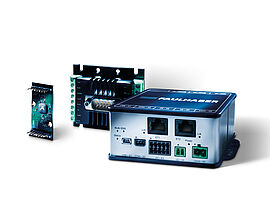Up to now, a camera has been used to record the course of the joint during laser welding. The computer then analyses the image and gives control commands to the welding robot, which then positions the laser head. The disadvantage of this solution is the delayed indirect movement of the head, which always "lags" behind the camera. For reliable optical "seam finding", surface, reflection and illumination must also remain as constant as possible. Deviations result in errors. Therefore the source of these errors has to be eliminated by performing painstaking adjustments. Committed to improving processes within this area, scansonic has chosen a pioneering approach: mechanical scanning.
Mechanically scanned
The developers broke new ground with the mechanical laser head guidance, utilising the essential prerequisites for joining. A shoulder always results at the joint of two sheets – the same applies to angle welding. This is either due to overlapping of the sheets or due to the joint gap. Today, filler material is often introduced to the welding focal point by means of a feed wire. A "scanning wire" is used for this purpose. If these two components are combined, an optimal, i.e. point-accurate, control of the welding head can be achieved.
If the filler wire is continuously pressed lightly against the edge of the overlapping sheet and this force is used as a parameter for the head control, the welding focal point follows the joint course with maximum accuracy. This occurs simultaneously with the movement of the head; delayed control of the head is not necessary. Deviations due to tolerances are compensated for immediately by such a procedure. The seam is thus always applied exactly at the point where it is required – at the edge of the overlap between the joint parts. As this scanning functions purely mechanically, neither optical reflection nor illumination or different sheet surfaces make any difference to the overall performance. Not even shadows or light flashes from other work processes will have an adverse effect. Because the filler wire, as a "lost sensor", is always renewed, there is also no wear.
Semi-independent laser head
In addition to mechanical scanning, the ALO head (Adaptive Laser Optics) offers further advantages. The integrated laser head performs fine adjustments to the weld seam itself. Instead of operating the control of the entire welding process via the welding robot, as in the conventional method, the new procedure allows much faster adjustments. The robot welding arm only predetermines the rough direction. The laser head control itself then performs the process of fine adjustment and tolerance equalisation on the seam in the range of + 5 mm. In order to obtain exact, reproducible results, scansonic is currently collaborating with the micromotor manufacturer FAULHABER. The requisite wire pressure is ensured by a sinusoidal motor with matching gearhead. This permits rapid and highly sensitive tracking of the entire laser head. The motor torque is evaluated, giving the dimension for the pressure. The sinusoidal motor with integrated motion controller allows precise detection of the motor current; accurate measurement is as easy as ABC. With this pressure control, the weld seam can be recorded in 2D in the x- and y-direction, and tracked precisely.
Tracking in the z-axis is undertaken by a telescopic arm with integrated path sensor. In combination with the tracked filler wire, this produces optimal, (laser) point-accurate tracking of the welding focal point exactly along the joint edge. As the head is capable of eliminating minor deviations itself, the robot control can be permanently set to the rough seam course. Set-up and programming of new welding heads take just a few hours, depending on the task.
Accurately positioned and evaluated
The FAULHABER sinusoidal motor is perfectly suited to this application. The extremely compact shape with integrated "piggy-back" motion controller is particularly conducive to a small, light-weight head design. The user-friendly "Motion Manager" software facilitates coordination with the respective welding parameters. Sensitive evaluation of the motor operating data is necessary for this purpose. Via the integrated control electronics, the drive current of the motor is determined and evaluated accordingly. In addition, the integrated analogue Hall sensors enable position detection. The necessary control signal for the laser head is thus calculated from position and current detection. As the motor is based on a highly dynamic design, readjustment can be performed very quickly in the event of deviations from the input values. The weld seam remains exactly on the "leading" joint edge of the sheets. The sinusoidal motor transmits the data to the control via RS 232 interface.
The new control system is characterised by optimal position determination at the exact welding focal point – with minimal effort. State-of-the-art FAULHABER technology made a valuable contribution to the success of this project.
Products




